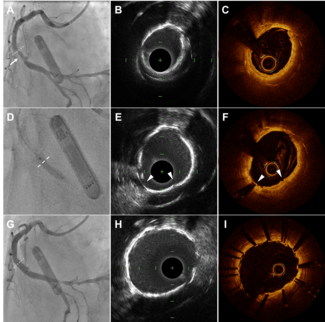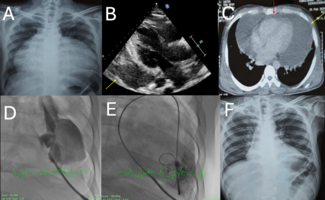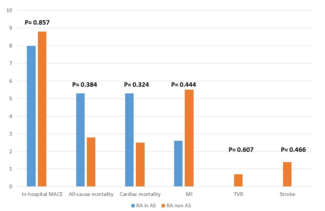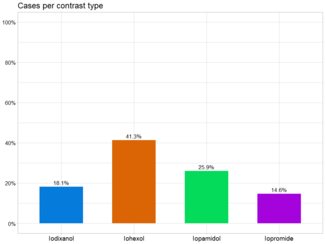Long-Term Outcomes Based on Time-to-Angiography in Patients Admitted with Non-ST-Segment Elevation Acute Coronary Syndromes
May 2005
The current American College of Cardiology/American Heart Association guidelines recommend coronary angiography and revascularization for patients with non-ST-segment elevation acute coronary syndromes (NSTE-ACS) and high-risk clinical features.1 This advantage of invasive approach is suggested by many contemporary randomized clinical trials demonstrating reduced death, myocardial infarction (MI), and recurrent angina in patients undergoing early angiography versus a conservative or ischemia driven strategy.2–4 Based on these data and the widespread availability of cardiac catheterization, it is not surprising that more than 60% of hospitalized patients with NSTE-ACS in United States hospitals undergo angiography within one week of hospital presentation.5
However, clinical trials have not addressed the optimal timing of coronary angiography following hospital admission for NSTE-ACS. Recent analysis from the Treat angina with Aggrastat and determine Cost of Therapy with an Invasive or Conservative Strategy-Thrombolysis in Myocardial Infarction 18 (TACTICS-TIMI 18) study failed to show benefit of early invasive strategy on death, myocardial infarction (MI), or rehospitalization.6 On the other hand, data from the single-center Intracoronary Stenting with Antithrombotic Regimen Cooling-Off (ISAR-COOL) trial suggest benefit from very early coronary angiography of ACS patients within six hours of presentation compared to delayed angiography at three to five days.7 However, most patients with ACS do not present to the hospital within six hours of symptoms and, in these patients, it is unclear whether early coronary angiography is better than initial medical therapy and delayed angiography. We therefore investigated the impact of the duration from hospital admission to coronary angiography on the outcome of patients admitted with NSTE-ACS.
Methods
Our study population consisted of consecutive patients admitted to the Coronary Intensive Care Unit (CICU) of the Henry Ford Hospital between January 1997 and December 2000 with admission diagnosis of NSTE-ACS. NSTE-ACS was defined as patients who presented with chest pain suggestive of unstable angina (chest pain > 30 minutes or worsening duration/severity of chest pain) with electrocardiographic changes (ST depression or new T-wave inversions in multiple leads) or positive markers of myocardial damage (creatinine kinase-MB or troponin). Patients with ST-segment elevation, cardiac arrest or cardiogenic shock, developing definite Q-wave MI, or not undergoing coronary angiography during the hospitalization were excluded. Clinical variables, angiographic results, and outcomes were obtained from electronic and written medical record, cardiac catheterization lab data forms, and the Henry Ford Hospital CICU Database. The Henry Ford CICU database is a prospective registry of every admission to the 16-bed CICU. The database includes 300 discrete data elements prospectively recorded on case report form by trained research assistants and updated links to the State of Michigan and Social Security death certificate registries. Left ventricular function was evaluated either by ventriculography or echocardiography and coronary artery disease severity assessed by digital coronary angiography). The decision regarding coronary angiography and the timing was made at the discretion of the treating physician with patient consent. Six-month clinical outcomes were collected using chart review. Mortality data were verified with the State of Michigan and Social Security death certificate registries with 3-year follow-up.
Patients were divided into 3 groups based on the time between hospital admission and coronary angiography: 1) Same-day/ 2 days/48 hours. The primary endpoints were 30-day, 6-month, and 3-year mortality. Secondary endpoints were major adverse coronary events (MACE) at 30 days and 6 months. MACE was defined as death, MI, repeat target vessel percutaneous coronary intervention (PCI), or coronary artery bypass surgery (CABG).
Statistical methods. Baseline demographic and clinical characteristics were compared between the groups using Analysis of Variance and chi-square analysis. For the binary occurrence of primary and secondary endpoints at discharge, 30 and 180 days, chi-square analysis was performed. The mortality rate between the groups was initially analyzed with pairwise comparisons. In addition, adjusted survival curves were constructed and compared with Cox-regression analysis. Adjustment was made for both baseline variables with unequal distribution (gender, peak creatinine kinase, and prior congestive heart failure) and other variables typically associated with mortality after ACS (age, race, systolic and diastolic blood pressure, heart rate, prior MI, left ventricular ejection fraction congestive heart failure, diabetes, peak creatinine kinase, and coronary artery disease severity). A p- value 2 days after admisison were older, more often female, and had higher rates of prior MI, congestive heart failure and pre-hospital nitrate use. Patients undergoing coronary angiography > 2 days were more often admitted to the hospital over the weekends.
Table 2 compares the in-hospital management of these patients. Patients undergoing angiography on the day of admission had a higher rate of balloon pump use. In contrast, patients undergoing angiography > 2 days had a higher pulse rate on admission with no difference in admission blood pressure. They also had less peak cardiac enzyme release. Hospital length of stay was significantly higher among patients undergoing coronary angiography > 2 days after hospital admission.
Table 3 compares the angiography and revascularization data between these groups. Angiographic findings of insignificant CAD was most common (12.5%) among patients undergoing angiography at 1 to 2 days, and was least common (6.8%) in patients undergoing coronary angiography on the same day of admission (p = 0.001). Three-vessel coronary disease was most common among patients undergoing coronary angiography > 2 days after CICU admission. There was no significant difference in left main artery disease and degree of LV dysfunction between the groups.
PCI procedures at the time of initial angiography were performed more often in patients undergoing same-day angiography, with progressively lower rates seen with increasing angiography delays (57% versus 48% versus 42%, p 2 days. At 6 months and 3 years, the > 2-day group had significantly higher mortality. No significant association or trend was seen in the rates of percutaneous revascularization procedures, bypass surgery, or MACE between the angiography groups after hospital discharge.
At 3 years, pairwise group testing showed no difference in mortality rates between patients undergoing 1- to 2-day angiography and same-day angiography (OR 0.91, 95% CI 0.51–1.63, p = 0.76; Table 5). However, there was increased mortality in patients undergoing > 2-day angiography versus same-day angiography (OR 2.37, 95% CI 1.42–3.98, p = 0.001) and 1- to 2-day angiography (OR 2.17, 95% CI 1.28–3.68, p = 0.004). Patients undergoing angiography > 2 days continued to have higher mortality than the same-day group after adjusting for age, gender, race, systolic and diastolic blood pressure, heart rate, prior MI, congestive heart failure, diabetes, peak creatinine kinase, coronary artery disease severity, and left ventricular ejection fraction, compared to the same-day group (OR 2.12, 95% CI 1.03–4.35, p = 0.04) and the 1- to 2-day group (OR 1.85, CI 1.04–3.32, p = 0.04; Figure 1). There was no difference in 3-year mortality between the 1- to 2-day and the same-day groups (OR 1.37, CI 0.63–3.00, p = 0.42).
Discussion
An important question in the treatment of patients with NSTE-ACS is the optimal time for angiography and revascularization following presentation to the hospital. Traditionally, most patients without acute complications are initially treated with medical therapy. After initial medical therapy, patients either undergo non-invasive risk stratification or invasive risk stratification with coronary angiography after variable waiting periods. Current guidelines emphasize early invasive evaluation in higher-risk patients with recurrent ischemia, congestive heart failure, arrhythmia, cardiogenic shock or mechanical complications.
The invasive strategy of coronary angiography followed by revascularization, if appropriate, is aimed at improving the long-term prognosis of patients with NSTE-ACS. Therefore, invasive risk stratification is recommended for NSTE-ACS patients, particularly those with high-risk features. Compared with a conservative strategy that reserves coronary angiography for persisting inducible ischemia, an invasive strategy has been shown to reduce the risk of adverse events including large myocardial infarction (MI), severe recurrent angina, and death2–4 in contemporary studies. It is, however, unclear whether early angiography is better than delayed angiography in patients undergoing invasive risk stratification. Since NSTE-ACS involves plaque rupture and thrombosis of coronary arteries, it is argued that initial medical therapy with antiplatelet and antithrombotic agents result in passivization and stabilization of the lesion. This may reduce recurrent ischemia and make revascularization safer. On the other hand, earlier angiography provides the opportunity to evaluate and treat the culprit lesions earlier. This may remove the ongoing silent or recurrent myocardial ischemia and lead to better outcomes.
The time-to-coronary angiography was variable in the major trials comparing invasive and conservative strategies (Table 6). In the Fast Revascularization during Instability in Coronary artery disease II (FRISC II) studies, the direct invasive approach was defined as coronary angiography within a few days of enrollment, aiming for revascularization within 7 days. In that study, the median time from hospital admission to angiography was 4 days in the invasive arm.2 The Treat angina with Aggrastat and determine Cost of Therapy with an Invasive or Conservative Strategy-Thrombolysis in Myocardial Infarction 18 (TACTICS-TIMI 18) study compared outcomes between the early invasive management group (coronary angiography 4 to 48 hours post-enrollment) and the conservative management (pre-discharge stress test) group. This protocol resulted in a median time of 22 hours from hospital admission to coronary angiography in the invasive arm.3 A similar time frame was achieved in the Thrombolysis in Myocardial Ischemia IIIB (TIMI IIIB) trial.8 These trials, however, did not study the relationship between outcomes and time between hospital admissions to coronary angiography. Thus, it is not clear whether earlier angiography results in better outcomes.
The Intracoronary Stenting with Antithrombotic Regimen Cooling-Off (ISAR-COOL) trial tested the hypothesis of whether prolonged antithrombotic pre-treatment is beneficial before catheter intervention in patients with unstable coronary syndromes. With the early intervention strategy, coronary angiography was performed within 6 hours of presentation, during which time antithrombotic pre-treatment was instituted. With the prolonged antithrombotic pre-treatment strategy, pretreatment was continued for at least 3 days, to a maximum of 5 days, after which all patients underwent coronary angiography. The early invasive approach resulted in a 5.7% absolute reduction in death and non-fatal myocardial infarction.7 This study suggests that very early (9
A recent analysis from the Treat angina with Aggrastat and determine Cost of Therapy with an Invasive or Conservative Strategy-Thrombolysis in Myocardial Infarction 18 (TACTICS-TIMI 18) trial failed to show the benefit of an early invasive strategy on the composite endpoint of 6 months death, myocardial infarction (MI), or re-hospitalization among the 1,078 patients randomized to the invasive approach. Individual endpoints were similar between patients who had angiography before or after 48 hours except for reinfarction, which occurred less frequently in the early angiography group (2.9 versus 6.5%, p = 0.08). Longer follow-up duration, however, may demonstrate differences between the groups.6
Our analysis demonstrates that when the invasive strategy is implemented in ACS patients, delayed coronary angiography was associated with increased 6-month and 3-year mortality. Although there was no difference in the re-infarction rate and the need for repeat revascularization in 6 months, patients who underwent coronary angiography > 2 days after admission had the least favorable outcome. There were significant differences in baseline variables between the groups. Analyzing the data, patients undergoing angiography very early ( 2 days) may have had delayed angiography due to other comorbidities. This group was older, had more three-vessel coronary artery disease, and underwent more coronary artery bypass surgeries after angiography.
The results of this study may have significant implications in the practice of risk stratification of acute coronary syndromes. The burden of NST-ACS is increasing in the general population as compared to ST-elevation MI.10 The use of antiplatelet agents, antithrombotics, beta-blockers, and statins have resulted in improved outcomes in hospitalized patients with ACS.11–14 Most patients in the U.S. undergo coronary angiography during index hospitalization for invasive risk stratification of these patients.15,16 The current study suggests that a delay in coronary angiography of more than 2 days is associated with worse long-term outcomes in these patients.
Study limitations. The retrospective study design, selection bias, treatment bias and unequal distribution of baseline comorbidities are the major limitations of our study. Patients were not randomized and assigned to an early invasive or late invasive approach, but instead underwent this procedure at the discretion of their treating physicians. The higher-risk patients, therefore, may have been considered for early intervention, and patients with higher comorbidities may have had angiography delayed. We attempted to adjust for the baseline confounding variables with multivariate analysis, but may not be able to account for all confounding variables and physician/treatment effects.
Conclusions
Patients with NSTE-ACS and high-risk features benefit from early coronary angiography and revascularization. However, it is unclear whether stable NSTE-ACS patients should undergo early coronary angiography or early medical therapy, followed by delayed angiography after some duration on medical therapy. This study suggests that in patients admitted to a coronary intensive care unit with NSTE-ACS, later (> 2 days after hospital admission) invasive risk stratification may be associated with worse 6-month and 3-year mortality rates. Randomized trials should be conducted to validate these findings.
1. Braunwald E, Antman E, Beasley J, et al. AHA Guidelines for the management of patients with unstable angina and non-ST-segment elevation myocardial infarction: Executive summary and recommendation. J Am Coll Cardiol 2002;40:1366–1374.
2. Wallentin L, Lagerqvist B, Husted S. et al. Outcome at 1 year after an invasive compared with a non-invasive strategy in unstable coronary-artery disease: The FRISC II invasive randomized trial. Lancet 2000;356:9–16.
3. Cannon CP, Weintraub WS, Demopoulos LA, et al. Comparison of early invasive and conservative strategies in patients with unstable coronary syndromes treated with the glycoprotein IIb/IIIa inhibitor tirofiban. N Engl J Med 2001;344:1879–1887.
4. Fox K, Poole-Wilson P, Henderson R, et al. Interventional versus conservative treatment for patients with unstable angina or non-ST-elevation myocardial infarction: The British Heart Foundation RITA 3 randomized trial. Lancet 2002;360:743–751.
5. Yusuf S, Flather M, Pogue J, et al. Variations between countries in invasive cardiac procedures and outcomes in patients with suspected unstable angina or myocardial infarction without initial ST-elevation. OASIS (Organization to Assess Strategies for Ischaemic Syndromes) Registry Investigators. Lancet 1998;352:507–514.
6. McCullough P, Gibson C, Dibattiste P, et al. Timing of angiography and revascularization in acute coronary syndromes: An analysis of the TACTICS-TIMI-18 trial. J Intervent Cardiol 2004;17:81–86.
7. Neumann F, Kastrati A, Pogatsa-Murray G, et al. Evaluation of prolonged antithrombotic pretreatment (“cooling-off” strategy) before intervention in patients with unstable coronary syndromes. JAMA 2003;290:1593–1599.
8. Effects of tissue plasminogen activator and a comparison of early invasive and conservative strategies in unstable angina and non-Q-wave myocardial infarction. Results of the TIMI IIIB trial. Thrombolysis in Myocardial Ischemia. Circulation 1994;89:1545–1556.
9. McCullough PA, O’Neil WW, Graham M, et al. A time to treatment analysis in the Medicine versus Angiography in thrombolytic (MATE) Trial. J Intervent Cardiol 2001;14:415–422.
10. American Heart Association, Heart and Stroke Statistics - 2004 update. Dallas, Texas. American Heart Association, 2004.
11. Baigent C, Collins R, Appleby P, et al. ISIS-2: 10-year survival among patients withsuspected acute MI in randomized comparison of intravenous streptokinase, oral aspirin, both or neither. The ISIS-2 (Second International Study of Infarct Survival) Collaborative Group. British Med J 1998;316:1337–343.
12. Yusuf S, Zhao F, Mehta SR ,et al. The Clopidogrel in Unstable Angina to Prevent Recurrent Events Trial Investigators. Effects of clopidogrel in addition to aspirin in patients with acute coronary syndromes without ST-elevation. N Engl J Med 2001;345:494–502.
13. Boersma E, Akkerhuis KM, Theroux P, et al. Platelet glycoprotein IIb/IIIa receptor inhibitor in non-ST-elevation acute coronary syndromes: Early benefit during medical treatment only, with additional protection during percutaneous coronary intervention. Circulation 1999;100:2045–2048.
14. Cannon CP, Braunwald E, McCabe CH, et al. Pravastatin or atorvatatin evaluation and infection yherapy-yhrombolysis in myocardial intensive versus moderate lipid lowering with statins after acute coronary syndromes. N Engl J Med 2004;350:1495–1504.
15. Bhatt DL, Roe MT, Peterson ED, et al. Utilization of early invasive management strategies for high-risk patients with non-ST-segment elevation acute coronary syndromes: Results from the CRUSADE Quality Improvement Initiative. 2004;292:2096–2104.
16. Fox KA, Goodman SG, Anderson FA, et al. From guidelines to clinical practice: The impact of hospital and geographical trends in the management of acute coronary syndromes. The Global Registry of Acute Coronary Events (GRACE). Eur Heart J. 2003;24:1414-24.


















